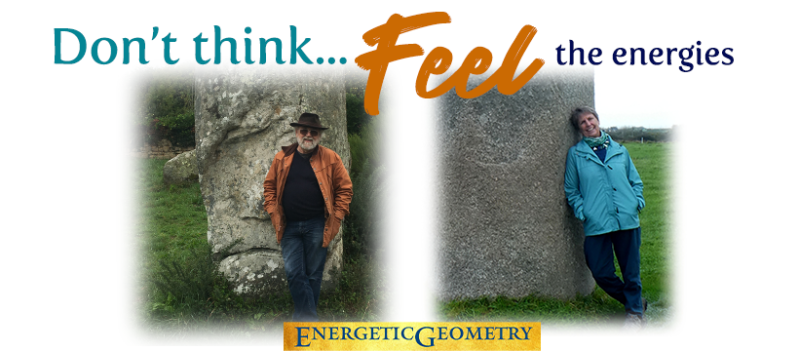Real sacred geometry is connected to the sun and the earth.
Real sacred geometry enhances your connection to the divine.
Real sacred geometry is harmonious and enhances life.
Real sacred geometry is not what you were led to believe.
Real sacred geometry is not primarily concerned with numbers such as Phi, the Golden Mean, or the Fibonacci spiral.
Real sacred geometry is the intimate connection of the earth with the sun, the moon, and the stars.
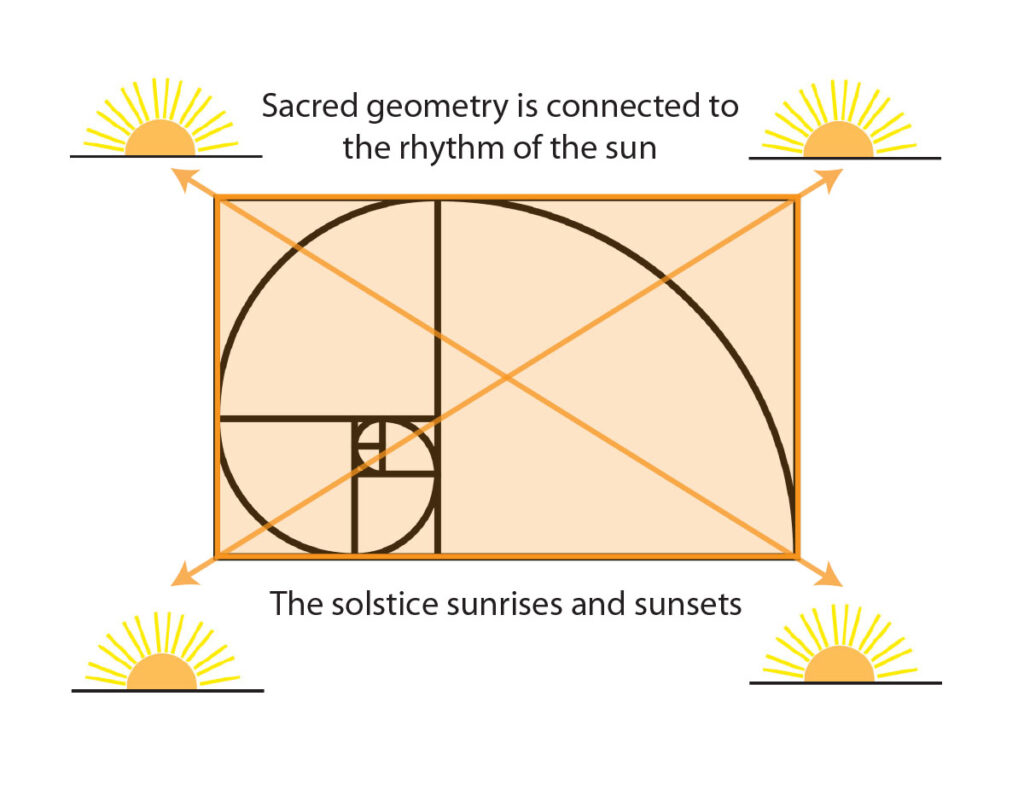
In this article, I will illustrate how the Golden Mean and the Fibonacci sequence are only pieces of the totality of sacred geometry. The streams of thought born in England, that the Golden Mean and Fibonacci sequences are the beginning and end of sacred geometry, are missing the most fundamental piece of the equation.
To begin our discussion, it is necessary to define the meaning of sacred. Most often the word 'sacred' is connected to a place where the human meets the divine. A word which nicely sums up the definition of sacred is ‘hierophany’, which means the appearance of the divine. Hierophany is a word made popular by Mircea Eliade in the 1950s in his seminal work The Sacred and the Profane: The Nature of Religion. Hierophany originates from Greek words hieros – sacred, and phaino – show or appear.
Where do humans meet the divine?
Again, Mircea Eliade gives us a little insight. "Every religion identifies a place and a time when the transcendent breaks into the world. When it does, it makes holy or sacred the place and the time of the breakthrough."
There were particular places for each culture where this transcendence appeared, and many times it became the center of their world. These places of breakthrough are where heaven and earth connect and can be called the axis mundi.
Each culture believes its homeland is the center of the world and their universe. This space is well known by the people and serves as a microcosm of order. At its center, the axis mundi is the most sacred place of all, and a meeting point of the four cardinal directions. Outside of its boundaries is chaos and the unknown.
The concept of the axis mundi is known by other names, including the world tree (tree of life), the world pillar, and the cosmic axis. The tree of life connects the heavens to earthly planes and through the roots to the underworld. Where the cosmos connects to the earth is a special place, which takes a variety of forms depending on the culture. There are high mountains, ancient trees, symbolic trees or sacred stones.
A marvelous stone marked some of these very first sacred places.
Examples can be found at Delphi with their carved omphalos stone, the navel of their world. Also in Ireland, the Stone of Destiny stands on top of the Hill of Tara. It was the sacred dwelling place of the gods and entrance to the underworld. At the holy center of Hindu temples, there is a stone called a lingam, which represents Lord Shiva and all the energies of the earth and beyond.

The Druids used actual trees for their axis mundi. Ancient oak trees were their spiritual centers and an integral part of their spirituality. The Indians held sacred a 3500-year old mango tree, where Shiva and Parvati were married. Many Mesoamerican cultures also had their world trees, embodying the four cardinal directions and axis mundi which connected the heavens with the earth and underworld.
After identifying a sacred place, protecting it, and safeguarding it was next.
So how did they design and build a holy space? A type of shape and measurement was needed. Clues to this measurement may be found in the Greek word geometry. Geo – means earth, and metron translates into the word measure. The roots of geometry began in the measurement of the land.
As well as needing measurement, organizing a sacred place is essential. The axis mundi is the connection between earth and a precise object in the cosmos, such as a star, planet, or constellation. The axis mundi is often associated with mandalas, and the simplest ones are comprised of a square and a circle which are a 2-dimensional representation of the axis mundi. The square represents the earth, and the circle represents the cosmos or heaven. There may also be four gates indicating the four cardinal points.
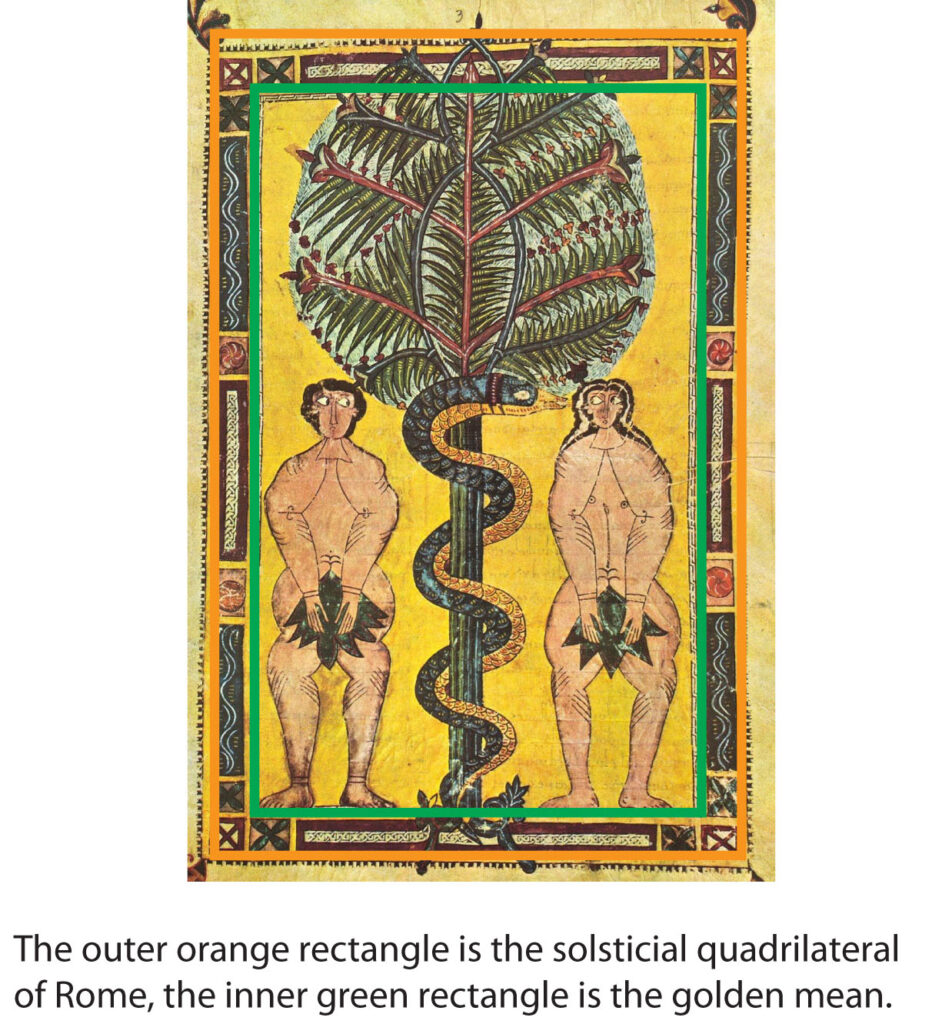
Because mandalas are a way of depicting the organization of sacred space, they become cosmic diagrams of the world, and some represent a heavenly paradise. For example, paradise for Christians is the Garden of Eden. It can be seen depicted in the 11th century Saint-Sever Beatus manuscript, which is enclosed by a rectangular wall, a type of shape and measurement.
Other cultures possess more elaborate mandalas. Perhaps the most well-known today comes from India and found in the Tibetan Kalachakra. Elaborately drawn with circles, squares, with the axis mundi in the sacred center, the mandalas present an orderly 2D representation of the cosmos. However, they actually portray a 3D view of their world.
To understand how this mandala was first conceived, we need to go back in time.
Imagine yourself in Neolithic times. What would be the most important celestial body to you? It would have to be the sun because, without it, there would be no life. It was no coincidence that the sun was the main god in many cultures, controlling life and death.
Early people tracked the sun's travels throughout the year. They knew it moved each day a little more north or south until it came to a halt twice a year and then reversed its direction. These two significant times of the year are the summer and winter solstices. Ancient people not only observed the path of the sun, but were also in tune with the cycles of the moon, the planets, and the stars.

For these early people, marking the solstice sunrise and sunset points was an essential part in the creation of their sacred places, because they marked the appearance of their god, the sun. Evidence of this is found in the many dolmens and passage tombs aligned to the rising or setting sun of the solstices and equinoxes. A famous example of an alignment to the winter solstice sunrise is at Newgrange in Ireland. Neolithic people also built stone circles and wooden henges aligned to the sun's patterns.
In Brittany, France, a different example of alignment to the solstices is found. The Crucuno Cromlech is a giant stone rectangle, whose four corners are aligned to a solstice sunrise or sunset. This rectangle is extraordinary in our search for real sacred geometry because it uses something special - measurements of the earth.
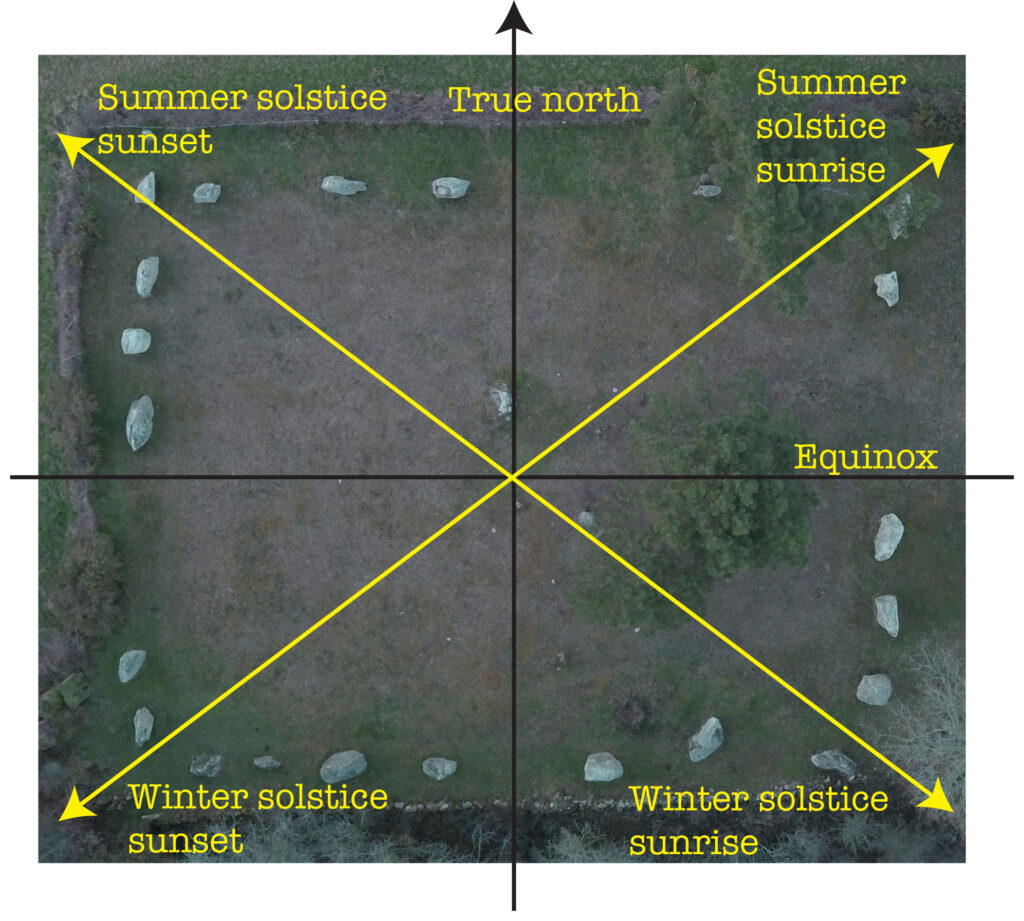
What does this mean?
As we mentioned before, ancient people tracked the movement of the sun throughout the year. From a bird's eye perspective, a rectangular shape emerges. This shape changes depending on its location on earth. For example, the further north or south of the equator is its position, the rectangle becomes more and more square-like. In Moscow, the figure created is a square, whereas, in Mexico City, it is a thin rectangle.
These angles are the measurement of the yearly pattern of our sun. However, they are not precise, because the rectangle can be any length. Another measurement is needed, which is given to us by the earth. A grid-like form is found on the surface of the planet, which is connected to the sun god. This grid or net emanates from the central core of the earth and was re-discovered by the Frenchman Dr. Peyré in 1937. It is an electromagnetic net running in north-south and east-west directions, curiously enough, in the cardinal directions. Its size varies with latitude, and it goes by several names, such as the solar net, natural net, Peyré net, and to the Hopi's it is called the Road of the Sun. The energy of the solar net dissipates when the sun goes down, which can be verified by dowsing, or sensed in the body or even seen by sensitive people. It was known as a golden net to our ancestors, and its measurements were used to build their sacred places.
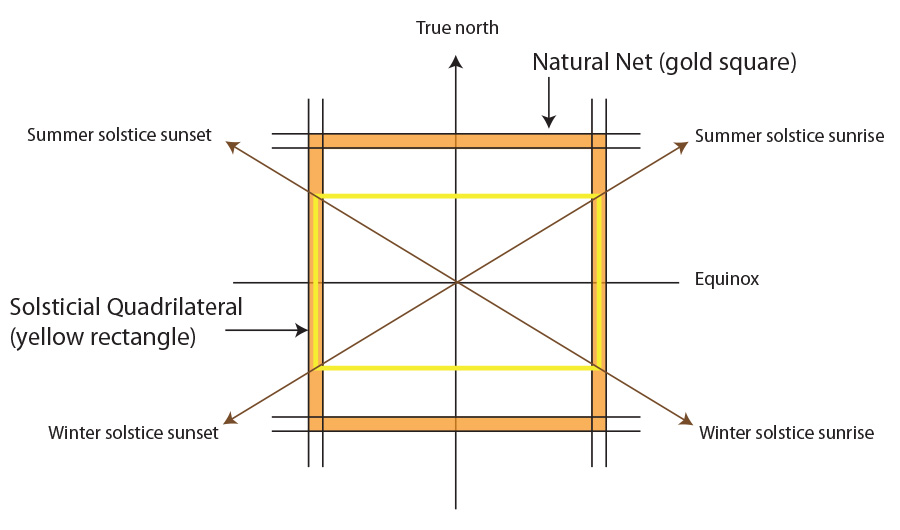
When the two measurements of the sun and the earth are combined, something magical occurs. A rectangular shape is created. This shape is not an ordinary rectangle; it has superpowers! It begins to organize the energies within it. Order emerges out of chaos, and this rectangle is the starting point for the mandala and the axis mundi. Another of its unique characteristics is that a vortex appears in the center, where there was nothing before. This vortex is fascinating because it is the place of hierophany, where we can meet the divine. It connects the earth with the sun, traveling all the way from the underworld to the cosmos, as does the axis mundi.
How does it work?
Firstly, when standing in the center of this solar rectangle, which we call a solsticial quadrilateral, a connection to the earth can be felt. It is a grounded feeling as if being pulled downwards into the earth. The energy then begins to rise through your central channel. Imagine a tube running through the center of your body from the ground to the top of your head. This energy moves up through the body, balancing and aligning the chakras as it rises. For many people, this is a very profound and spiritual experience, especially when it reaches the throat chakra. This chakra is the gateway to the connection to higher vibrations and the ability to access spiritual planes. When this chakra opens for the first time, people are so overwhelmed with joy they begin to cry. The energy continues to the crown and upwards to the cosmos and spirit.
This simple rectangle, the solsticial quadrilateral, is the first sacred space and was used all over the world to build temples, churches, and homes. It is the real sacred geometry. From the basic measurements found in the solsticial quadrilateral, a mandala can be created, with squares, circles, and the five elements. The cosmology of the universe is ordered and structured inside and the axis mundi is present in the center.
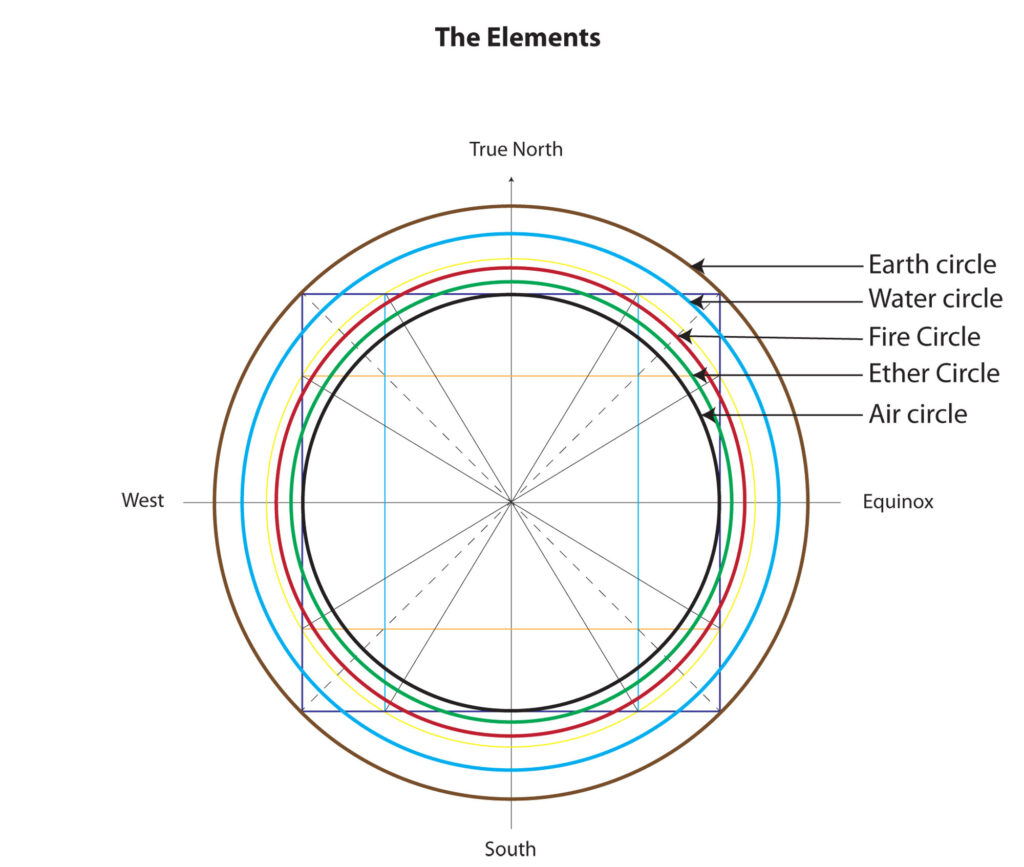
One crucial quality of this solsticial quadrilateral, besides its universal use around the world, is that it is alive and connected to life. The union between the solar energies and the earth creates its measurements, because of this, the measurements have an intimate connection to the land, the place, and the people.
This relationship to the place makes the measurements a changing dynamic. The Golden Mean is actually found in the solar mandala hidden in polygons such as the pentagon. It is also found in the relationship between the musical notes and the Elements.
The Golden Mean was not the only proportion used by ancient cultures. The 345 triangle which has the proportion of 1.333 was also well known by the ancients. The Hindus, Greeks, Egyptians, and Mayans all used it in building their temples. The 345 triangle was considered more important than the Golden Mean because rectangular angles were made possible. An interesting bit of history is found in the European master builder tradition concerning the prevalent use of the 345. Master builders used to wear a belt called the 12-knot rope. This rope was comprised of 13 knots of equal spacing. Its cubit measurement was found in the solar mandala.

These relationships illustrate that the two main proportions, the 345 (1.333) and the Golden Mean (1.618), are generated by the mandala. However, it is crucial to understand that developing a geometry based solely on the Golden Mean without reference to the sacred solar mandala, is a huge mistake. Without a connection to the earth and life, it will not work well, and it is potentially dangerous. People become ungrounded, losing their connection to reality, developing difficulties in manifesting their ideas, their business, and their goals.
As an example, if we look at a tree, it is rooted into the earth, and the growth of its leaves and branches could be related to the Golden Mean, but its leaves are like solar panels, always connected to the sun. As you can see, the Golden Mean is the only part of the development of the tree. It is the same for buildings, it is first necessary to connect the structure to the earth and sun, then incorporate the measurement of the Golden Mean. To be effective, the Golden Mean needs to be anchored to the earth, just like all plants, trees, animals, and humans. Real sacred geometry is this anchor, connected to the sun, to the earth, and to life itself.
This knowledge of building with the solar mandala and the solsticial quadrilateral was known to all the ancient builders, such as the Egyptians, Greeks, Romans, Hindus, Muslims, Mayans, Incas and was used until the Age of Enlightenment. The influence of Napoleon who standardized measurements in France signaled the end of the use of solar measurement. Before this, measurements were different in each region and were related to the solar geometry of the place in relation to the latitude.
There are a few ways to learn more about how this real sacred geometry works. Our book Secrets of Sacred Geometry; Solar Geometry for Health and Life is one. We also have online classes and certification programs for those who want to investigate further. To have a look around our new website and see what interests you. To learn more about real sacred geometry read Karen’s blog called: The Energetics of the Fibonacci Spiral and the Golden Mean.
